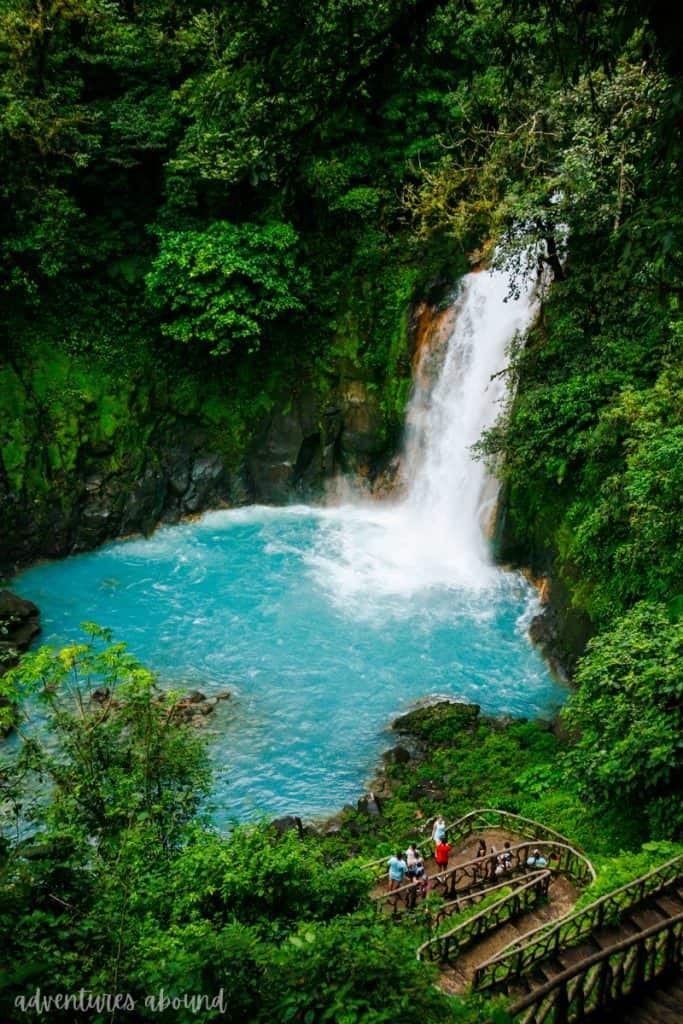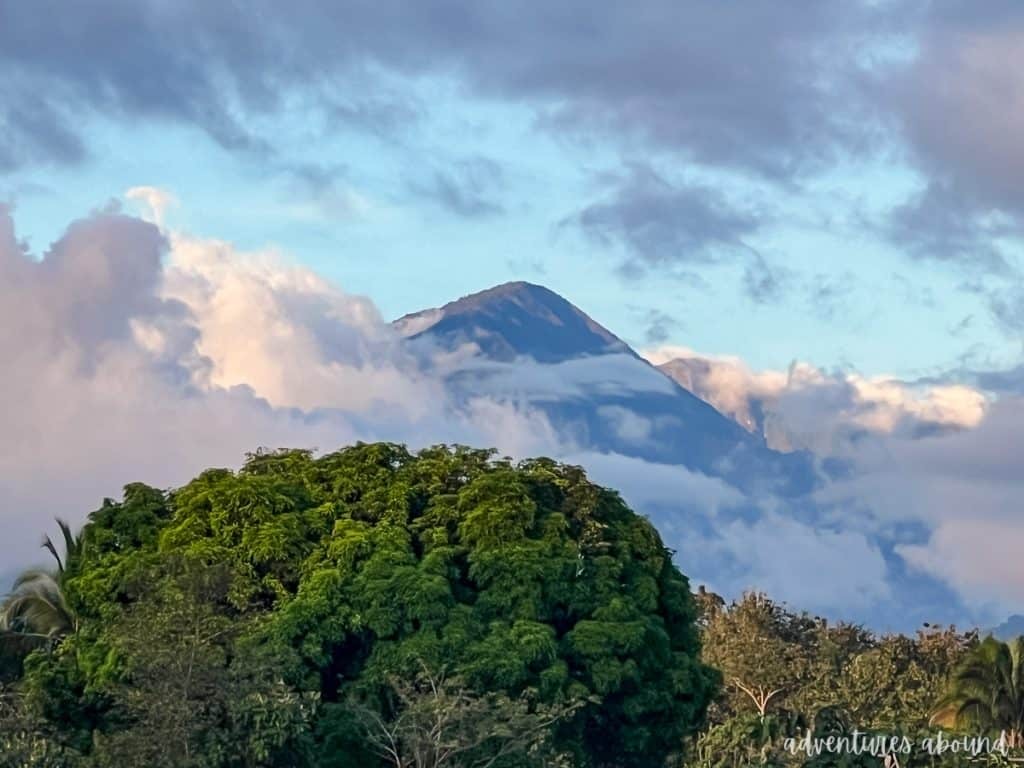Costa Rica Visitors Guide from CONDUCT.EDU.VN is your ultimate resource for exploring this vibrant nation, packed with invaluable travel advice and practical tips to help you navigate everything from lush rainforests to pristine beaches. With our expert insights and comprehensive itineraries, planning your Costa Rican adventure has never been easier, covering ecotourism, wildlife encounters, and sustainable travel.
1. Unveiling Costa Rica: Your Essential Visitors Guide
Costa Rica, nestled in Central America, is a jewel brimming with biodiversity and adventure. This section offers a comprehensive overview for first-time and seasoned travelers alike, ensuring a smooth and enriching experience.
1.1. Geographic Overview
Costa Rica is strategically located between Nicaragua and Panama, offering coastlines on both the Pacific Ocean and the Caribbean Sea. This unique position contributes to its diverse ecosystems and climates.
1.2. Language and Communication
The official language is Spanish, with its own distinctive Costa Rican slang. English is widely spoken in tourist areas, particularly by younger generations, making communication relatively easy for international visitors. On the Caribbean coast, you might encounter English-Creole, reflecting the region’s rich cultural influences.
1.3. Visa Requirements and Entry
U.S. citizens can stay up to 180 days without a visa. Ensure your passport is valid for at least six months beyond your intended stay. Costa Rica also offers digital nomad visas for those looking to work remotely for up to two years, as detailed on the official Visit Costa Rica website.
1.4. Currency and Costs
The local currency is the Colón (CRC), with an exchange rate fluctuating around 500 CRC to 1 USD. Costa Rica is considered the most expensive country in Central America; prices can be comparable to those in the U.S., so budget accordingly.
1.5. Climate and Best Times to Visit
Costa Rica enjoys a tropical climate with relatively warm temperatures year-round. The dry season, from January to April, is ideal for travel, with minimal rainfall. The rainy season spans from May to November. The Caribbean coast has different weather patterns, with drier spells in March-April and September-October. Be aware of El Niño/La Niña patterns, which can cause significant deviations from normal weather.
1.6. Regional Breakdown by Province
Costa Rica is divided into seven provinces, each offering unique experiences.
- Guanacaste: Famous for its Pacific beaches, surfing, and dry tropical forests.
- Puntarenas: The largest province, featuring diverse wildlife, national parks, and coastal attractions.
- Alajuela: Home to active volcanoes, lush coffee plantations, and adventure tourism.
- Heredia: Known as “Little Switzerland” for its picturesque hills and quaint villages.
- San Jose: The capital city, blending urban life with cultural heritage.
- Cartago: Rich in colonial history and architecture, offering a glimpse into Costa Rica’s past.
- Limon: Showcasing Afro-Caribbean culture, vibrant music, and stunning rainforests.
2. Discovering Costa Rica: A Tapestry of Attractions
Costa Rica offers a wide array of attractions from coffee plantations to stunning beaches, making it a premier destination for various interests.
2.1. World-Renowned Coffee Culture
Coffee is integral to Costa Rican culture. The high altitudes and fertile volcanic soils produce beans highly valued worldwide. Visiting a coffee farm is a must for coffee lovers, where you can learn about the cultivation and roasting processes. Costa Rican coffee is a symbol of national pride and a global commodity.
2.2. Natural Wonders: Landscapes and Biodiversity
Costa Rica’s compact size belies its incredible biodiversity. It boasts beaches, waterfalls, rainforests, cloud forests, rivers, hot springs, and volcanoes. This natural diversity makes it a prime destination for nature enthusiasts and adventurers.
2.3. Adventure Tourism: Thrills and Exhilaration
Costa Rica is a hub for adventure travel, offering activities like ziplining, hiking, river rafting, surfing, and waterfall rappelling. Whether you are a seasoned adrenaline junkie or a beginner, there are ample opportunities to test your limits.
2.4. Wildlife Encounters: A Biodiversity Hotspot
Costa Rica is home to approximately 4% of the world’s biodiversity. You can spot four species of monkeys, migrating whales, vibrant birds, and nesting turtles. The sloth, a symbol of the “pura vida” lifestyle, is a must-see. Keep an eye out during your travels for chances to see these creatures in their natural habitats.
2.5. Cultural Heritage: Oxcarts and Traditions
Costa Rica’s cultural heritage is rich and diverse, with traditions passed down through generations. One iconic symbol is the hand-painted oxcart, particularly prominent in Sarchí. These colorful carts are not only a cultural icon but also a testament to the country’s artistic heritage.
3. Navigating Costa Rica: Transportation Options
Getting around Costa Rica requires some planning. A mix of public and private transport options cater to different budgets and preferences.
3.1. Public Transportation: Buses
Costa Rica’s bus system is extensive and affordable. Buses reach even remote areas, offering an immersive cultural experience. This is a great way to meet locals and practice your Spanish.
3.2. Domestic Flights: Quick and Convenient
Small flights offer a quicker way to reach remote areas like Tortuguero and Corcovado National Park. Although pricier than buses, they save significant travel time.
3.3. Boat Services: Coastal Transfers
Boats provide faster access to destinations like Tortuguero and the Nicoya Peninsula compared to buses. While more expensive than public transport, they offer a convenient and scenic route.
3.4. Private Shuttles: Comfort and Convenience
Private shuttles are available to popular tourist destinations. Ideal for groups with lots of luggage or those who prefer direct transfers, these can be booked in advance.
3.5. Private Drivers: Personalized Experience
Hiring a private driver can be a valuable option, especially for groups. Drivers, often locals, offer insights and recommendations, enhancing your travel experience.
3.6. Taxis and Ride-Sharing: Urban Transport
Taxis are readily available in major cities. Ensure the meter is used or agree on a price beforehand. Uber also operates, though technically illegal, and may offer cheaper alternatives.
3.7. Car Rentals: Freedom to Explore
Renting a car offers the most flexibility, allowing you to explore at your own pace. Be aware that insurance is mandatory and can significantly increase the overall cost.
4. Must-Do Activities in Costa Rica: Tailored Experiences
Costa Rica offers a wide range of activities catering to various interests, from urban explorations to natural adventures.
4.1. San Jose: Urban Exploration
San Jose, often overlooked, has much to offer. Explore museums, enjoy international cuisine, and relax in its parks. The capital provides a cultural counterpoint to the country’s natural attractions.
4.2. Beaches: Coastal Paradise
Costa Rica’s beaches are world-renowned. Popular options include:
- Guanacaste: Papagayo, Tamarindo, Playa Conchal, Playas del Coco.
- Nicoya Peninsula: Montezuma, Sámara, Nosara, Manzanillo.
- Pacific Coast: Jacó, Playa Hermosa, Punta Leona, Manuel Antonio, Dominical, Uvita.
- Caribbean Coast: Puerto Viejo (Playa Negra, Playa Cocles, Punta Uvita, Playa Chiquita, Playa Manzanillo).
4.3. Volcanoes: Majestic Giants
Visit one of Costa Rica’s volcanoes, each unique:
- Irazú: Offers panoramic views and easy access.
- Poás: Known for its impressive crater.
- Arenal: Famous for its conical shape and surrounding activities.
- Rincón de la Vieja: Features geothermal activity and hiking trails.
- Tenorio: Home to the stunning Rio Celeste.
4.4. National Parks: Biodiversity Sanctuaries
Costa Rica’s national parks are treasure troves of biodiversity.
- Braulio Carillo: Ideal for hiking and wildlife spotting near San Jose.
- Carara: A biological bridge between ecosystems, perfect for birdwatching.
- Cahuita: Offers coral reefs, beaches, and rainforests.
- Tortuguero: Known for its mangrove forests and sea turtle nesting.
- Manuel Antonio: Features beautiful beaches and abundant wildlife.
- Chirripó: Home to Costa Rica’s highest peak.
- Palo Verde: A haven for water birds in Guanacaste.
- Corcovado: Hailed as one of the most biologically intense places on earth.
5. Exploring Key Destinations: In-Depth Insights
Several destinations stand out in Costa Rica. Each offers unique experiences that cater to diverse interests.
5.1. Monteverde: Cloud Forest Adventures
Monteverde is a cloud forest filled with mist and incredible biodiversity. Known for excellent ziplining, it’s a must-visit for nature and adventure enthusiasts.
5.2. La Fortuna: Arenal’s Neighbor
Located near Arenal, La Fortuna is popular for hiking, white water rafting, and horseback riding. Don’t miss the La Fortuna Waterfall, La Paz Gardens, and numerous hot springs.
5.3. Rio Celeste: The Blue River
Located within Tenorio Volcano National Park, Rio Celeste is known for its vibrant blue river. The otherworldly turquoise hue makes it a popular destination.
5.4. Osa Peninsula: Remote Biodiversity
The Osa Peninsula, including Corcovado National Park, Drake Bay, and Puerto Jimenez, is perfect for eco-tourism and wildlife enthusiasts. It offers a remote and biodiverse experience.
6. Day Trips from San Jose: Quick Escapes
San Jose is a great base for exploring nearby attractions. Several day trips offer unique cultural and natural experiences.
6.1. Cartago: Historical Capital
Once Costa Rica’s capital, Cartago is known for the Basilica of Our Lady of the Angels and the ruins of Santiago Apostol Church. It also serves as a gateway to Irazu Volcano National Park.
6.2. Alajuela: Birthplace of a Hero
Alajuela, northwest of San Jose, is the birthplace of Juan Santamaria. Visit his museum and the Central Park. Zoo Ave, a wildlife rescue center, is a highlight for animal lovers.
6.3. Heredia: The City of Flowers
Heredia features colonial architecture and the Church of the Immaculate Conception. Coffee enthusiasts can visit Café Britt, one of Costa Rica’s most famous coffee farms.
6.4. Sarchí: Craftsmanship and Art
Sarchi is famous for its colorful painted oxcarts. Visit the workshops and shop for traditional Costa Rican handicrafts. It’s also home to the world’s largest hand-painted oxcart.
6.5. Zarcero: Topiary Art
Zarcero is known for its whimsical topiary garden and striking pink and blue church, offering a unique cultural experience.
6.6. Orosi: Tranquil Valley
Nestled in a valley, Orosi features the oldest church still in use in Costa Rica. Explore Tapanti National Park and relax in local hot springs.
7. Safety and Security: Travel Smart
While Costa Rica is generally safe, awareness and precautions are necessary.
7.1. Theft and Pickpocketing
Theft and pickpocketing are common in larger cities like San Jose. Keep valuables secure and avoid displaying expensive items.
7.2. Night Safety
Avoid walking alone at night, particularly in urban areas, where petty theft is more common.
7.3. Emergency Contacts
The emergency number in Costa Rica is 911.
7.4. Travel Insurance
Travel insurance is essential to protect against illness and other unforeseen events.
8. Costa Rica Travel Guide: FAQ
8.1. What is the best month to visit Costa Rica?
The best time to visit is during the dry season, from December to April. Avoid traveling during Christmas and Holy Week to avoid crowds.
8.2. Is Costa Rica safe for travel?
Yes, Costa Rica is generally safe. However, be aware of petty theft and take precautions, especially in tourist areas.
8.3. Is Costa Rica expensive or cheap?
Costa Rica is relatively expensive compared to other Central American countries. Prices in tourist areas can be similar to those in the U.S.
8.4. Is tipping customary in Costa Rica?
Most restaurants include a 10% service tip. Additional tipping is not necessary, as service providers are typically paid a living wage.
8.5. Is it illegal to remove shells or sand from Costa Rica?
Yes, it is illegal to remove sand or shells from Costa Rica. These items will be confiscated at airport security.
8.6. Can you drink tap water in Costa Rica?
Yes, tap water is generally safe to drink, except in the southern Caribbean area of Puerto Viejo, where bottled water is recommended.
9. Exploring Costa Rica: A Visitor’s Guide to Ethical Conduct
As you prepare to explore the breathtaking landscapes and vibrant culture of Costa Rica, CONDUCT.EDU.VN emphasizes the importance of responsible travel. Being mindful of local customs and ethical guidelines will not only enhance your experience but also contribute to the preservation of this incredible destination for future generations. Here’s a guide to ethical conduct for visitors in Costa Rica.
9.1 Respecting Wildlife and Nature
Costa Rica is renowned for its biodiversity. As such, it is important to observe wildlife from a distance, avoid feeding animals, and refrain from touching or disturbing their habitats.
9.1.1 Guidelines for Wildlife Observation
- Maintain a Safe Distance: Use binoculars or zoom lenses to observe animals without encroaching on their space.
- Avoid Flash Photography: Flash can startle or disorient animals.
- Do Not Feed Animals: Feeding wildlife can alter their natural behaviors and diets.
- Stay on Marked Trails: This minimizes disturbance to natural habitats.
- Support Eco-Tourism: Choose tour operators that adhere to sustainable practices and conservation efforts.
9.1.2 Legal Protections for Endangered Species
Costa Rica has strict laws protecting its endangered species. According to the Costa Rican Biodiversity Act, harming or capturing wildlife can result in hefty fines and even imprisonment. (Source: Costa Rican Ministry of Environment and Energy).
9.2 Cultural Sensitivity and Respect
Engaging with the local culture with respect and sensitivity is crucial for a positive travel experience.
9.2.1 Understanding Local Customs
- Greetings: A handshake is common for formal greetings, while a kiss on the cheek is typical among friends and family.
- Dress Code: Dress modestly when visiting religious sites.
- Tipping: While not mandatory, tipping for good service is appreciated.
- Language: Learning basic Spanish phrases can greatly enhance your interactions.
- Punctuality: Costa Ricans are generally relaxed about time, so be patient if things don’t happen exactly on schedule.
9.2.2 Supporting Local Economy
- Shop Local: Buy souvenirs and crafts directly from local artisans to support their livelihoods.
- Eat Local: Try traditional Costa Rican cuisine at family-owned restaurants.
- Stay Local: Choose locally-owned accommodations to contribute to the community’s economic well-being.
9.3 Environmental Stewardship
Protecting Costa Rica’s environment is essential for its sustainability.
9.3.1 Reducing Your Environmental Impact
- Use Reusable Items: Bring your own water bottle, shopping bag, and utensils.
- Conserve Water: Be mindful of water usage, especially in areas with limited resources.
- Proper Waste Disposal: Dispose of trash properly and recycle whenever possible.
- Choose Eco-Friendly Products: Use biodegradable soaps and shampoos.
- Support Sustainable Tourism: Opt for tours and accommodations that prioritize environmental conservation.
9.3.2 Supporting Conservation Efforts
- Volunteer: Participate in local conservation projects such as beach cleanups or reforestation efforts.
- Donate: Contribute to environmental organizations working to protect Costa Rica’s natural resources.
- Educate Others: Share your experiences and promote responsible travel practices among your friends and family.
9.4 Guidelines for Sustainable Travel
| Aspect | Sustainable Practice |
|---|---|
| Accommodations | Choose eco-lodges that implement sustainable practices. |
| Transportation | Use public transport, rent electric cars, or bikes whenever possible. |
| Activities | Participate in eco-tours that promote conservation. |
| Consumption | Buy local products and reduce waste. |



9.5 Legal and Ethical Considerations
| Consideration | Guideline |
|---|---|
| Permits | Obtain necessary permits for activities like hiking and camping in protected areas. |
| Respect Laws | Adhere to local laws and regulations. |
| Cultural Artifacts | Do not remove or disturb archaeological or historical artifacts. |
9.6 Emergency Contacts and Resources
| Contact | Information |
|---|---|
| Emergency Number | 911 |
| Tourism Police | Provide assistance to tourists and address safety concerns. |
| Costa Rican Red Cross | Offer medical assistance and emergency services. |
9.7 Conclusion
By following these guidelines, visitors can ensure they leave a positive impact on Costa Rica while enjoying its natural beauty and cultural richness. CONDUCT.EDU.VN encourages all travelers to embrace ethical conduct and contribute to the sustainability of this remarkable destination.
10. Conclusion: Embrace the Pura Vida
Costa Rica offers a diverse range of experiences, from adventure and nature to culture and relaxation. By using this guide, you can plan an unforgettable trip. Embrace the “pura vida” lifestyle, respect the environment, and enjoy all that Costa Rica has to offer. For more in-depth information and guidance, visit conduct.edu.vn at 100 Ethics Plaza, Guideline City, CA 90210, United States, or contact us via Whatsapp at +1 (707) 555-1234.